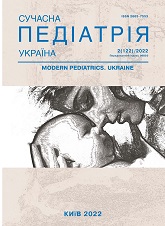Clinical effectiveness of sodium hyaluronate gel usage for prevention of postoperative adhesion in children
DOI:
https://doi.org/10.15574/SP.2022.122.21Keywords:
sodium hyaluronate, adhesions, small bowel obstructionAbstract
It was considered expedient to study the effectiveness of intraoperative prevention of adhesion formation in children based on the results of our own experimental and clinical studies on the effectiveness of using an anti-adhesive gel based on cross-linked sodium hyaluronate.
Purpose - to evaluate clinical efficacy and safety of cross-linked sodium hyaluronate gel (SHG) usage as a barrier agent for primary prevention of postoperative peritoneal adhesions formation in children.
Materials and methods. This is a prospective, randomized, controlled, patient blinded observational study, which includes 62 children. All patients underwent laparotomy for appendicular peritonitis and were randomly divided into two equal groups. Patients from group A (n=31) received conventional surgical treatment, SHG was additionally applied in group B (n=31) before abdominal closure. Immediate and long-term effects of SHG usage were investigated to evaluate the influence on adhesions reformation. The average period of postoperative observation was 14.0±2.4 months.
Results. SHG application was associated with no increase in complications rate: duration of postoperative ileus, need in nasogastric decompression, intensive care unit state, hospital state, the incidence of surgical site infection, and need for relaparotomy did not differ significantly between compared groups. The prevalence of peritoneal adhesions at the end of in-hospital treatment differs significantly between groups according to the ultrasound data (χ2=10.930; p=0.005). The incidence of small bowel obstruction (SBO) developed during the follow-up period in group A (16.1%) was significantly higher than in group B (3.23%) where the anti-adhesive gel was applied (χ2=4.026; p=0.045).
Conclusions. Intraoperative use of SHG based on sodium hyaluronate allows reduction of postoperative adhesions formation in children without worsening the postoperative course.
The research was carried out in accordance with the principles of the Helsinki declaration. The study protocol was approved by the Local ethics committee of all participating institutions. The informed consent of the patient was obtained for conducting the studies.
No conflict of interests was declared by the authors.
References
Capella-Monsonís H, Kearns S, Kelly J, Zeugolis DI. (2019). Battling adhesions: from understanding to prevention. BMC biomedical engineering. 1: 5. https://doi.org/10.1186/s42490-019-0005-0; PMid:32903353 PMCid:PMC7412649
Catena F, Di Saverio S, Coccolini F, Ansaloni L et al. (2016). Adhesive small bowel adhesions obstruction: Evolutions in diagnosis, management and prevention. World journal of gastrointestinal surgery. 8 (3): 222-231. https://doi.org/10.4240/wjgs.v8.i3.222; PMid:27022449 PMCid:PMC4807323
Di Saverio S, Podda M, De Simone B, Ceresoli M et al. (2020). Diagnosis and treatment of acute appendicitis: 2020 update of the WSES Jerusalem guidelines. World journal of emergency surgery: WJES. 15 (1): 27. https://doi.org/10.1186/s13017-020-00306-3; PMid:32295644 PMCid:PMC7386163
Gerner-Rasmussen J, Donatsky AM, Bjerrum F. (2019). The role of non-invasive imaging techniques in detecting intra-abdominal adhesions: a systematic review. Langenbecks Arch Surg: 653-661. https://doi.org/10.1007/s00423-018-1732-8; PMid:30483880
Isa MA, Bodnar OB. (2017). Hyaluronic acid solution as a treatment of adhesive intestinal obstruction in children - A positive effect: PS230. Porto biomedical journal. 2 (5): 246. https://doi.org/10.1016/j.pbj.2017.07.164; PMid:32258776 PMCid:PMC6806913
Melnichenko M, Sytnikova V, Kvashnina A. (2018). The effect of anti-adhesive gels based on sodium hyaluronate on the formation of intraperitoneal adhesions in the experiment. Klin. Khirurhiia. 85 (12): 64-67. https://doi.org/10.26779/2522-1396.2018.12.64
Miyake H, Seo S, Pierro A. (2018). Laparoscopy or laparotomy for adhesive bowel obstruction in children: a systematic review and meta-analysis. Pediatric surgery international. 34 (2): 177-182. https://doi.org/10.1007/s00383-017-4186-0; PMid:29018940
Schmitt VH, Mamilos A, Schmitt C, Neitzer-Planck C et al. (2018). Tissue response to five commercially available peritoneal adhesion barriers-A systematic histological evaluation. Journal of biomedical materials research. Part B. Applied biomaterials. 106 (2): 598-609. https://doi.org/10.1002/jbm.b.33835; PMid:28263453
Sultana T, Gwon JG, Lee BT. (2020). Thermal stimuli-responsive hyaluronic acid loaded cellulose based physical hydrogel for post-surgical de novo peritoneal adhesion prevention. Materials science & engineering. C, Materials for biological applications. 110: 110661. https://doi.org/10.1016/j.msec.2020.110661; PMid:32204089
Ten Broek R, Krielen P, Di Saverio S, Coccolini F et al. (2018). Bologna guidelines for diagnosis and management of adhesive small bowel obstruction (ASBO): 2017 update of the evidence-based guidelines from the world society of emergency surgery ASBO working group. World journal of emergency surgery: WJES. 13: 24. https://doi.org/10.1186/s13017-018-0185-2; PMid:29946347 PMCid:PMC6006983
Wu W, Cheng R, das Neves J, Tang J et al. (2017). Advances in biomaterials for preventing tissue adhesion. Journal of controlled release: official journal of the Controlled Release Society. 261: 318-336. https://doi.org/10.1016/j.jconrel.2017.06.020; PMid:28652071
Downloads
Published
Issue
Section
License
Copyright (c) 2022 Modern pediatrics. Ukraine

This work is licensed under a Creative Commons Attribution-NonCommercial 4.0 International License.
The policy of the Journal “MODERN PEDIATRICS. UKRAINE” is compatible with the vast majority of funders' of open access and self-archiving policies. The journal provides immediate open access route being convinced that everyone – not only scientists - can benefit from research results, and publishes articles exclusively under open access distribution, with a Creative Commons Attribution-Noncommercial 4.0 international license (СС BY-NC).
Authors transfer the copyright to the Journal “MODERN PEDIATRICS. UKRAINE” when the manuscript is accepted for publication. Authors declare that this manuscript has not been published nor is under simultaneous consideration for publication elsewhere. After publication, the articles become freely available on-line to the public.
Readers have the right to use, distribute, and reproduce articles in any medium, provided the articles and the journal are properly cited.
The use of published materials for commercial purposes is strongly prohibited.

